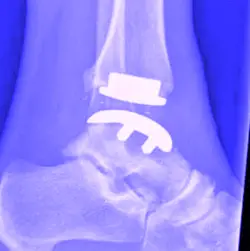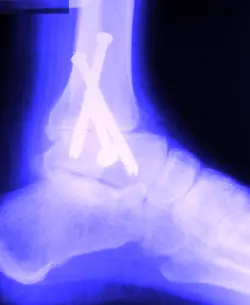AUTHOR: Marc Mitnick DPM
ankle arthroplasty (remodeling of the joint)
home --> ankle arthroplasytotal reconstruction of ankle joint
It is important to mention the date of this article which is July, 2015. The reason I bother to state the date is simply because in the world of ankle surgery, particularly that of ankle implants, the technology is changing at a very rapid rate.

|
If you scan the internet for information on ankle implants (artificial joints), you will get a very diversified opinion as to the long term effectiveness of ankle implants. In spite of the fact that implants have been available for other joints of the body, for a long time, with a good track record, it seems that has not been the case with the ankle joint.
Total ankle arthroplasty has been performed over the last 40 years or so and whenever a new technique or new materials were introduced, there seemed to be an early air of enthusiasm soon to be followed by disappointment.
The higher than normal failure rates for ankle implants can be attributed to the following:
- poor patient selection- patients that are too young, meaning since the life expectancy of an ankle implant is 10-15 years, it could be assumed that the implant will eventually fail in a younger individual and the patient would be looking at another surgery sometime in the future. Additionally, since younger patients tend to me more active, they put more stress on the implant and generally do not do as well as the older population.
An obese patient is another criteria that will expedite implant failure. For obvious reasons, if a patient is extremely overweight this over stresses the ankle joint and the implant and increases the possibility for implant failure.
Diabetics, simply because of the inherent lower extremity problems a poorly controlled diabetic exhibits, this too can lead to implant failure. Many diabetics simply should not have lower extremity surgery because of poor vascular status and increased chance of infection and the inability to fight infection should one occur.
Osteoporosis, or demineralization of bone. If the bone stock of the ankle and tibia bone are not adequate, at the very least, the implant if more likely to loosen up and then fail.
Abnormal alignment of the foot and leg potential patients who have abnormal alignment in their legs, knee joint or even in foot function need to be evaluated for these discrepancies and adjustments made in preparation for implant surgery.
Abnormal gait patterns in individuals who suffer from neurological disease such as Parkinson's disease or Multiple Sclerosis or other similar disease entities.
- poor implant materials-both the type of implant material and their design have lead to problems with sustainability of the implant. As time moves forward, better materials and better inherent design will lead to better outcomes.
- surgeon experience-anyone performing this type of surgery should be adept at both the various types of ankle implants on the market, along with a great deal of experience implanting artificial joints. Additionally, a complete understanding of the biomechanics of the lower extremity is very important, as no two people walk the same.
ANKLE IMPLANT VERSUS ANKLE FUSION
ankle fusion
Prior to the advent of ankle implants, the only real option in chronic ankle pain was to fuse the ankle joint. Keep in mind that this article is about chronic, severe ankle pain that has not responded to more conservative treatments.

|
Conservative treatments that should be tried prior to ankle arthroplastic procedures include orthotics, AFO or ankle-foot orthosis which is essentially a combination orthotic and ankle brace, physical therapy, cortisone injections and ankle arthroscopy.
Although ankle fusions generally work out well, there are inherent problems with this procedure. Because the ankle joint is fused, meaning there is no longer any motion within that joint, it tends to put excessive pressure on the adjacent joints, in particular the subtalar joint which is the joint just below the ankle joint.
Since normal gait is predicated on the ability of the ankle to bend, when this motion has been stunted, it has to change the gait pattern in the individual.
The amount of damage that can be done will depend on a number of factors.
- The amount of existing arthritis already present in the adjacent joints.
- The amount of excess weight that the patient carries.
- The overall activity level of the patient
- The degree of variation in gait that the fusion causes. Some people have limited ankle joint motion even in "normal" walking, so they would be affected less then those that once had excellent motion in the ankle joint.
It is estimated that roughly ten percent of people who have had an ankle fusion will go on to require a fusion of an adjacent joint.
ankle implant
The attraction to an ankle implant is the hope that the painful degenerated ankle joint can be replaced with an artificial joint which will allow the individual to return to some semblance of a normal life style. This is particularly true of the younger, more active person. Of course, as already stated, there is always the concern about the patient out living his implant and the need for another surgery.
Studies comparing ankle fusions vs. ankle implants have generally found that both groups function similarly when walking on flat surfaces. People who have had ankle implants tended to exhibit better functionality when going up and down stairs and ambulating on uneven surfaces.
takeaway points on ankle fusion vs. ankle implant
- Total joint remodeling of the ankle joint is only performed in individuals with chronic ankle pain where more conservative therapies have failed.
- The procedure is usually limited to those with a history of arthritis, including traumatic arthritis, non-inflammatory arthritis such as osteoarthritis which is the "wear and tear" arthritis we all suffer from in varying degrees, and inflammatory arthritis, from disease states such as rheumatoid arthritis.
- It is imperative you find a surgeon who has performed many ankle implants. He or she will more than likely give you more options and help guide you in your decision making. Your expectations should not exceed the reality.
- Not all patients are candidates for an ankle implant. Right now ankle fusions are the more popular procedure.
- As time passes, ankle implants are improving and expected outcomes are improving as well.
REFERENCES


Recent Articles
-
Vitamin D impact on health
Feb 06, 23 07:17 PM
Researchers are suggesting that the effectiveness of Vitamin D in fighting and preventing disease is predicated on a persons body mass index (BMI). The thinner the person the greater the positive impa… -
Foods to speed up healing
Feb 01, 23 02:41 PM
One of the best ways to help yourself heal faster after surgery is to eat well. Getting the proper nutrition will provide your body with the essentials it needs to promote healing. Here is a suggestio… -
Cancer and Type 2 Diabetes
Jan 25, 23 04:52 PM
An article revealing that older type 2 diabetics have a higher incidence of cancer then non-diabetics. It is suggested that cancer may surpass CVD as the number one cause of death in older diabetics. -
Does glucosamine or MSM reduce arthritis pain?
Jan 22, 23 01:41 PM
A good review of the possible benefits to taking glucosamine, chondroitin or MSM for arthritis. Always beware of the possible side effects of over the counter supplements. -
shin splints
Jan 18, 23 05:12 PM
A great review on the various causes of shin splints, along with treatment options. -
Whats new in skin cancer?
Jan 15, 23 08:32 PM
A presentation of newer skin protection combinations in an effort to better protect the skin from the hazards of sun exposure. -
Causes and risk factors of warts
Jan 14, 23 05:02 PM
A good review of the causes of warts and protective measures you can take to prevent developing them. -
Do chronic wounds need to be dressed daily?
Jan 11, 23 02:18 PM
Because of supply chain shortages as well as staffing shortages particularly during the pandemic, many institutions extended the time between dressing changes for chronic wounds. Is this really the be… -
Food choices that raise your risk of type 2 diabetes
Jan 08, 23 10:07 AM
A good review of how blood sugars can become elevated and the harm that can do. Certain food groups have a tendency to raise your blood sugars and should be avoided. -
Outcome stats from Scarf bunionectomy
Jan 03, 23 03:04 PM
The Journal of Foot and Ankle Surgery recently reported a meta analysis of outcomes in 1583 Scarf bunionectomies that met their inclusion criteria. Adverse events did not seem to be any better or wors…